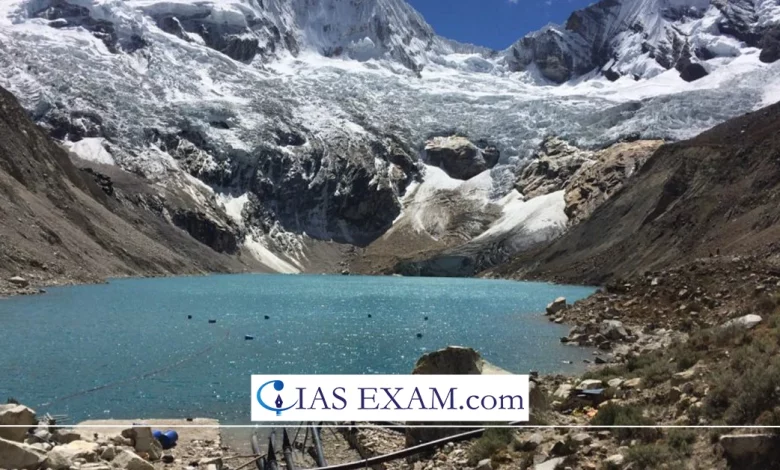Uttarakhand Government Evaluates Glacial Lake Outburst Flood Risk
Syllabus: Geography [GS Paper-1], Disaster Management[GS Paper-3]

Context
The Uttarakhand government has initiated a comprehensive risk assessment of glacial lakes within the state, focusing on five that have been identified as high-risk for potential Glacial Lake Outburst Floods (GLOFs).
Key Points
- The NDMA has identified 188 Himalayan glacial lakes that are in danger of overflowing due to excessive rainfall.
- Thirteen of these lakes are located in Uttarakhand.
- The lakes have been categorised into three risk levels, with five of them being highly sensitive and at increased risk of Glacial Lake Outburst Floods (GLOFs).
- These lakes include Vasudhara Tal in Chamoli district and four lakes in Pithoragarh district.
- These lakes vary in size from 0.02 to 0.50 square kilometres and are located at elevations ranging from 4,351 to 4,868 metres above sea level.
Glacial Lake Outburst Flood
- Glacial Lake Outburst Floods (GLOFs) are catastrophic events resulting from the sudden release of water from glacier-fed lakes. Understanding the dynamics and triggers of GLOFs is crucial for mitigating their risks.
- Triggers of GLOFs: GLOFs are served as results by a number of causes for example glacier melt, torrential downpours and seismic activity. These disasters have the capacity to erode and topple natural dams holding in the lakes that are glacial. This will cause the dam’s failures leading to flowing water.
- Impacts of GLOFs: The consequences of the GLOFs are the calamities that lead to flash floods and disastrous impacts downstream the rivers. These natural hazards endanger critical human settlements, the environment and the natural infrastructure. Rubbish, erosion and the slide land and set multiple damages which are caused by the floodwaters mixed with debris, sediment, and boulders.
- Prevalence in Mountainous Regions: GLOFs are the highest risk in the mountainous areas such as the Himalayan, Andes, and Alps because the existence of the lakes or glaciers are at high rise in these regions. The vulnerability of these areas to climate change is no doubt a major factor contributing to outburst of GLOFs.
- The Situation in Uttarakhand: Many glaciers and glacial lakes in Uttarakhand, India thereby a high possibility of GLOFS is a point of concern. The demonstration of state government toward GLOF risk screening draws a picture of the essence of preventive steps taken in vulnerable regions.
Glacial Lake
- Glacial lakes are formed as a result of the melting of glaciers. As glaciers retreat due to rising temperatures, they leave behind depressions in the landscape.
- These depressions are then filled with water, forming glacial lakes. The size and depth of these lakes can vary widely, ranging from small ponds to large bodies of water.
- Glacial lakes are typically characterised by their cold, pristine waters, often tinted with a milky blue hue due to the presence of fine glacial sediment known as “rock flour.”
- They are usually located in high-altitude areas, often surrounded by rugged mountain terrain and fed by glacial meltwater.
- Importance: Glacial lakes serve a vital function both within and out of their respective ecosystems and hydrological systems. They are a lifeline for dense downstream population densities as they supply the pristine drinking water that feeds agriculture, water is a renewable energy resource used for the production of electricity. Besides lakes play a significant role in providing thriving ecosystems of flora and fauna that have transferred to high and cold mountain landscapes.
- Vulnerability to Climate Change: Glacial lakes get susceptible to the effect of climate change, mostly because of receding glaciers. One of the significant consequences of global warming is the melting of glaciers becoming faster each year and thus an expansion as well as an increase in glacial lakes through illicit means.
- Hazards: Glacial lakes are sources of essential benefits, but they act as danger to people living in nearby communities. A release of the natural dams, which might get caused because of the reasons like earthquakes or discreet thawing of snow melting glaciers, can end up by having more severe GLOFs.
- Management and Monitoring: Control and monitoring efforts concerning glacial lakes prove to be the key determinants in countering the risk factors linked to Glacial Lake Outburst. This involves close observations of glacial movements, evaluating the security of natural dams and creating systems of early warning to alert downstream populations in case there is a danger of flood.
Conclusion
The Uttarakhand government’s proactive approach to assessing the risk of GLOFs is an important step in disaster preparedness and mitigation. This initiative underscores the importance of ongoing vigilance and cooperation in addressing the challenges of climate change and its impact on vulnerable regions.
Source: The Indian Express
UPSC Mains Practice Question
Q.Discuss the causes, impacts, and mitigation strategies associated with Glacial Lake Outburst Floods (GLOFs). In your response, analyse the environmental and socio-economic consequences of GLOFs, considering their effects on vulnerable mountainous regions.





.png)



